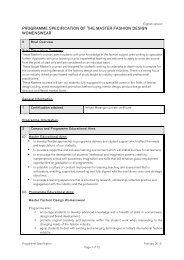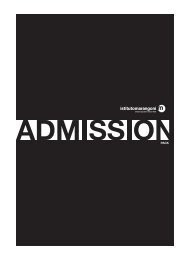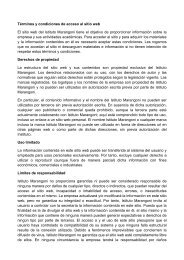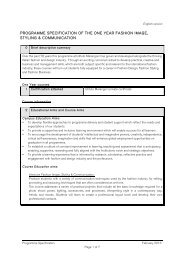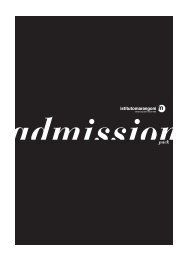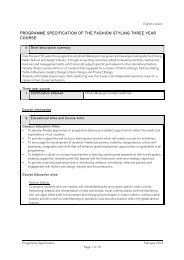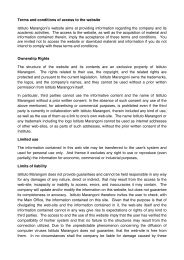london & paris programme specification BA ... - Istituto Marangoni
london & paris programme specification BA ... - Istituto Marangoni
london & paris programme specification BA ... - Istituto Marangoni
You also want an ePaper? Increase the reach of your titles
YUMPU automatically turns print PDFs into web optimized ePapers that Google loves.
MMU Programme Specification – Fashion Design<br />
A combination of different learning and teaching methodologies are employed in order to promote reflective<br />
learning and develop generic transferable skills.<br />
Methods include:<br />
• projects to encourage independent learning through investigation, enquiry and problem solving;<br />
• group project to enhance interpersonal and collaborative skills;<br />
• tutorials and group tutorials to facilitate shared experiences and best practice;<br />
• Seminars, formal lectures and workshops<br />
• Scholastic trips, external projects and competitions present the students with another dimension to<br />
their leaning experience.<br />
• Guest speakers provide the students with a full, broader and real prospective to their specialist field<br />
of study.<br />
Students will have the opportunity to demonstrate their achievement of the intended learning outcomes<br />
through a variety of means appropriate to their field of study:<br />
The <strong>BA</strong> (Hons) Fashion Design course is part of the three-year full time <strong>programme</strong>, with an option to<br />
undertake a four-year sandwich <strong>programme</strong>. This <strong>programme</strong> is delivered through a variety of learning and<br />
teaching methods, which include seminars, tutorials, workshop inductions, study visits, lectures, IT workshops,<br />
library sessions, group projects, and independent research.<br />
At Level 4 the unit framework will provide an opportunity for students from widely varied backgrounds and<br />
abilities to learn the fundamentals of drawing ensuring that by the end of the year they will become proficient<br />
in expressing their ideas in 2D with good presentation skills.<br />
Pattern cutting and construction classes throughout the first year will give students an introduction to the<br />
technical skills required and how they relate to, and are supported by academic practice and contemporary<br />
fashion design issues. Students will compile a technical file, which includes construction, details and<br />
manipulations. Portfolio and Collection Creation Unit will help students aim towards the production of an<br />
individual portfolio and sketchbooks with photographic reference; sketches, ideas, collages, fabric samples<br />
and a range plan for different markets. A great deal of the focus is placed on working towards practical output<br />
through projects set by tutors.<br />
The units comprising Level 5 are designed to encourage students to experiment widely and challenge their<br />
existing ideas and approach to design implementing skills learnt from Level 4. To this end, units will<br />
encourage the students to experiment and develop their own personal style. Students will target their<br />
collections to a variety of market segments. The creative work will take place in the design and pattern<br />
making studio, a realistic working environment in which students experiment with fabrics, print, pleating,<br />
silhouettes and details. Students will work with fabric suppliers, print/knit technicians and sample machinists<br />
towards the production of their capsule collection, developing their practical skills with the support of tutors.<br />
Level 5 units will prepare students to express, evaluate and present ideas and information clearly in a variety<br />
of forms appropriate to the situation and audience. At this level, students will be introduced to the practice of<br />
keeping Reflective Learning Journals.<br />
Students on the sandwich <strong>programme</strong> who successfully complete level 5 have the option to progress to the<br />
Placement Year. This is normally for a minimum period of 36 weeks and on satisfactory completion the<br />
student is awarded 120 Practice Credits. The Placement Panel, however, reserves the right to recommend to<br />
the appropriate Examination Board that a student should progress directly onto the Level 6 of the <strong>programme</strong><br />
and thus graduate with a full-time award.<br />
Whereas Level 5 encourages diverse experimentation and a challenging approach to thinking, at Level 6<br />
students’ skills are honed to increasingly produce well-informed finished pieces of work that communicate<br />
their ideas. By this stage the students are aiming to work as independent practitioners.<br />
Fashion Marketing within units will help students to research and analyse different markets, understand<br />
consumer demographics, competitors, price points, marketing methods, promotion and the preparation of a<br />
business plan. At this level of study the student will be equipped to work as a self-employed entrepreneur.<br />
The introduction to Reflective Learning Journals at Level 5 will endow them with the self-analysis necessary<br />
__________________________________________________________________________________________<br />
Programme Specification 6 of 18 April 2011



